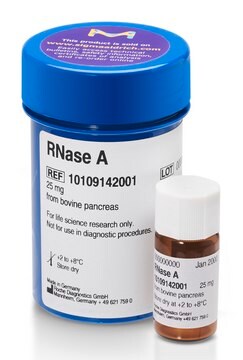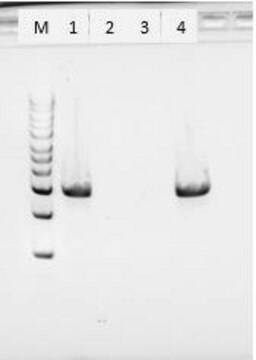RPROTKSOL-RO
Roche
Protéinase K, recombinante, de qualité PCR
Solution from Pichia pastoris
About This Item
Produits recommandés
Produit recombinant
expressed in Pichia pastoris
Niveau de qualité
Forme
buffered aqueous solution (18 ± mg/mL; pH 7.5)
Activité spécifique
~2.5 units/mg protein
Conditionnement
pkg of 1.25 mL (03115887001)
pkg of 25 mL (03115844001)
pkg of 5 mL (03115828001)
Fabricant/nom de marque
Roche
pH optimal
6.5 and 9.5
Plage de pH
4.0-12.5
Température de stockage
2-8°C
Description générale
Application
- This PCR grade Proteinase K is extremely effective on native proteins and can therefore be used to rapidly inactivate endogenous nucleases such as RNases and DNases. This property makes Proteinase K particularly suitable for the isolation of native RNA and DNA from tissues or cell lines.
- The enzyme promotes cell lysis by activating a bacterial autolytic factor.
- Proteinase K is also used for the analysis of membrane structures by modifying proteins and glycoproteins on cell surfaces.
- The enzyme is particularly well suited for isolating nucleic acids for amplification reactions.
Caractéristiques et avantages
- Choose an effective tool for template preparation. Inactivate DNases and RNases of most species.
- Count on consistent quality and performance. Stringent quality testing ensures optimal stability and high-level lot-to-lot performance.
- Prepare samples over a wide range of conditions. The robust enzyme is stable over a wide pH range and is ideal for diverse applications.
- Benefit from a contamination-free enzyme. The enzyme is tested for the absence of RNases and DNases, and is virtually free of DNA. It is especially suited for the isolation of PCR templates.
Qualité
Absence of Nucleases: Each lot is tested on various substrates to ensure the absence of endonuclease, exonuclease, ribonuclease, and nicking activity.
Teneur en ADN : ≤10pg/mg enzyme (determined by Threshold)
Biocharge : ≤5cfu/g (determined by the most stringent test from the European Pharmacopoeia, which identifies the total number of viable aerobic bacteria, yeast, and fungi)
Définition de l'unité
Notes préparatoires
Solution de travail : Tampons suggérés :
The most appropriate buffer for Proteinase K will vary from application to application. Always follow the pH and temperature guidelines in parameter filed. As a general rule, proteinase K is stable and very active in buffers that contain denaturing reagents such as urea, sodium dodecyl sulfate (SDS), and guanidinium salts.
Inhibiteurs: ® However, it is not inactivated by metal ions, chelating agents (e.g., EDTA), sulfhydryl reagents, or trypsin and chymotrypsin inhibitors.
Autres remarques
The enzyme can reduce protein to free amino acids if it is present in large excess for long incubation periods.
Informations légales
Mention d'avertissement
Danger
Mentions de danger
Conseils de prudence
Code de la classe de stockage
12 - Non Combustible Liquids
Classe de danger pour l'eau (WGK)
WGK 1
Point d'éclair (°F)
No data available
Point d'éclair (°C)
No data available
Certificats d'analyse (COA)
Recherchez un Certificats d'analyse (COA) en saisissant le numéro de lot du produit. Les numéros de lot figurent sur l'étiquette du produit après les mots "Lot" ou "Batch".
Déjà en possession de ce produit ?
Retrouvez la documentation relative aux produits que vous avez récemment achetés dans la Bibliothèque de documents.
Les clients ont également consulté
Notre équipe de scientifiques dispose d'une expérience dans tous les secteurs de la recherche, notamment en sciences de la vie, science des matériaux, synthèse chimique, chromatographie, analyse et dans de nombreux autres domaines..
Contacter notre Service technique









